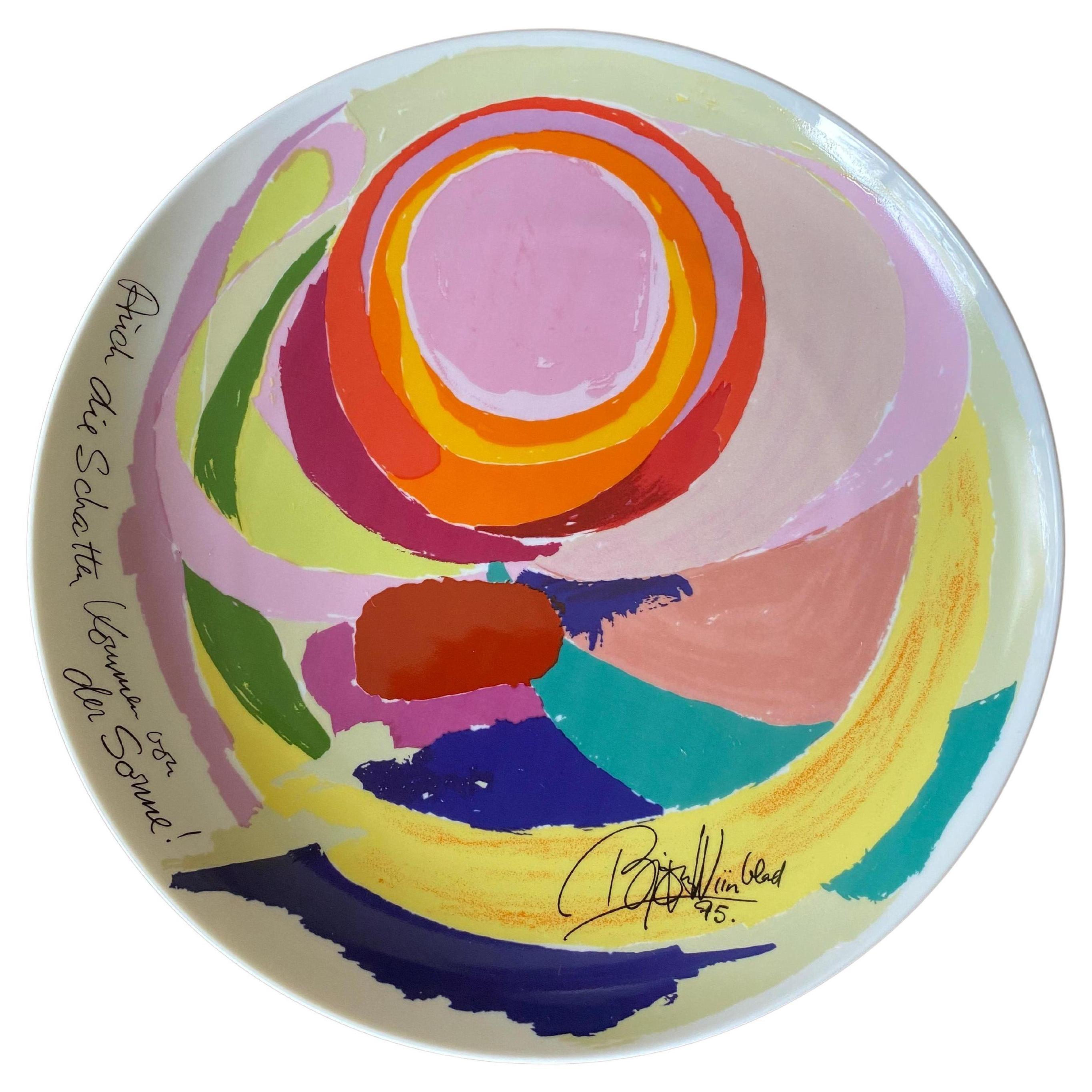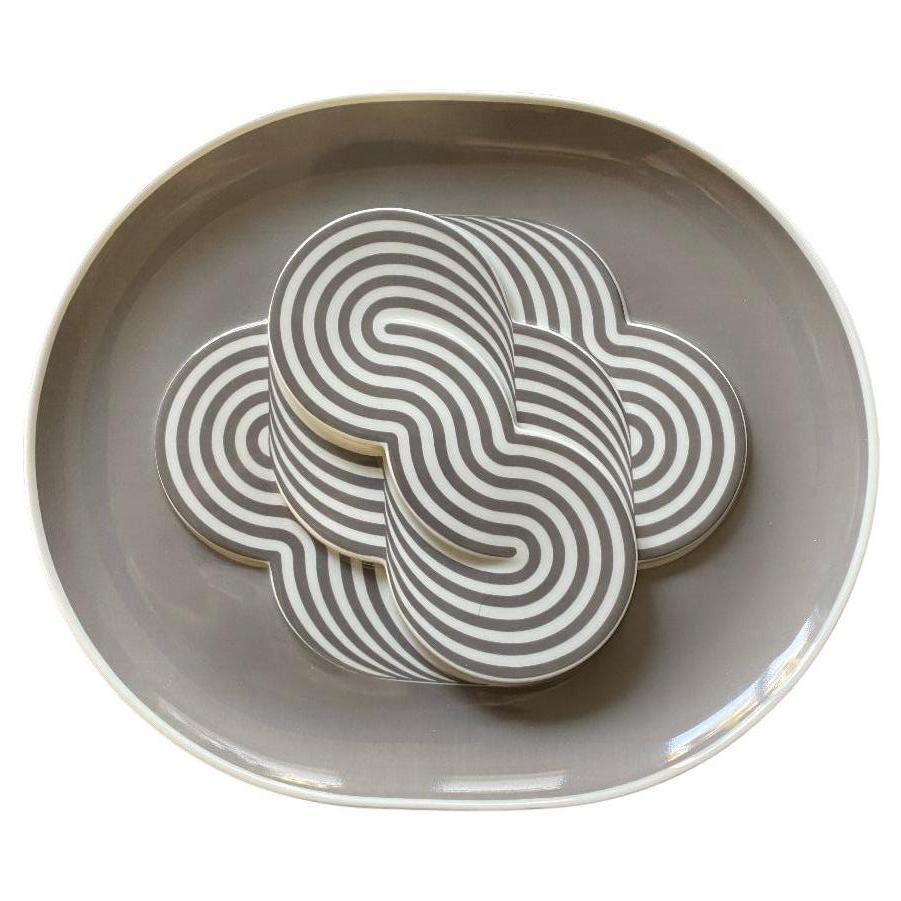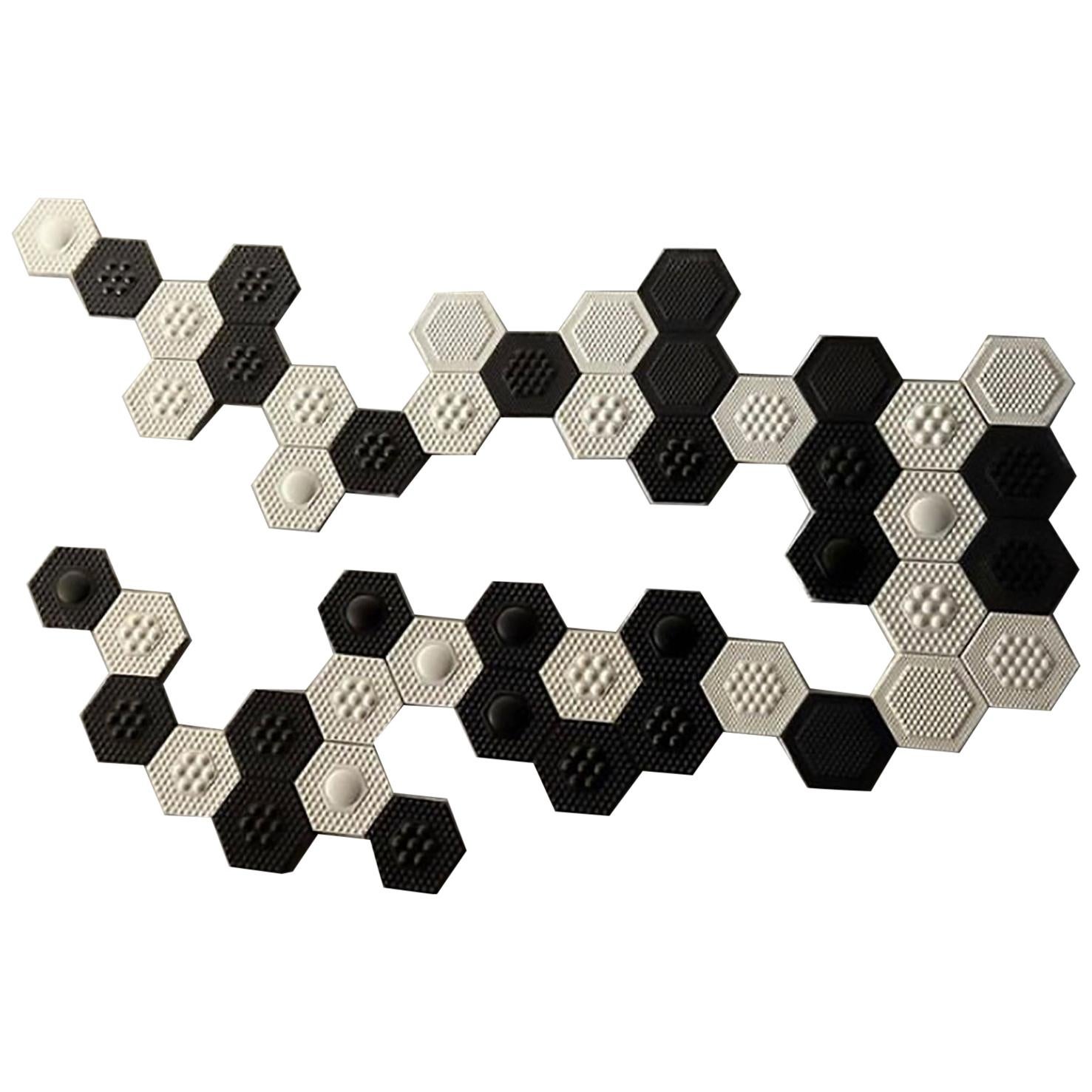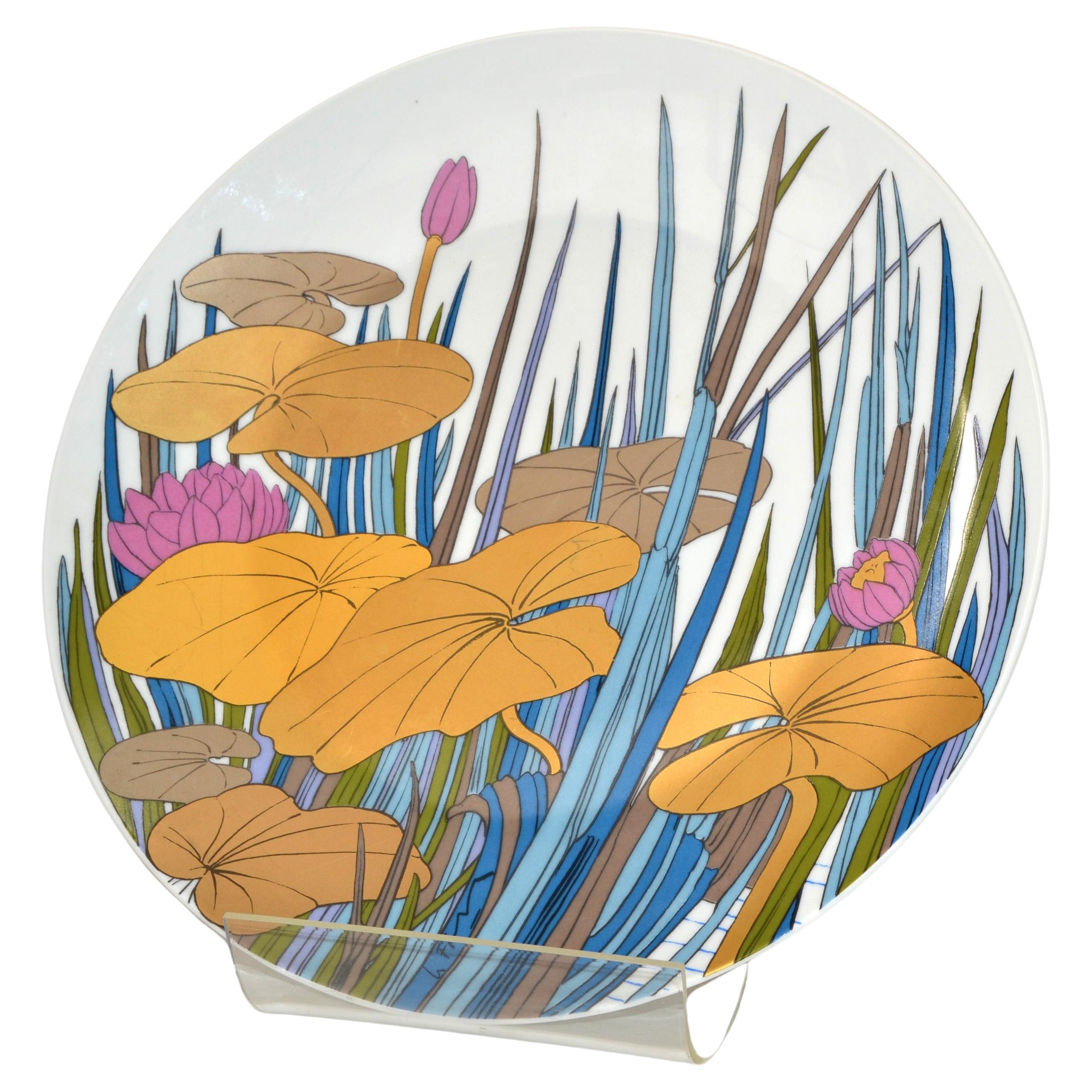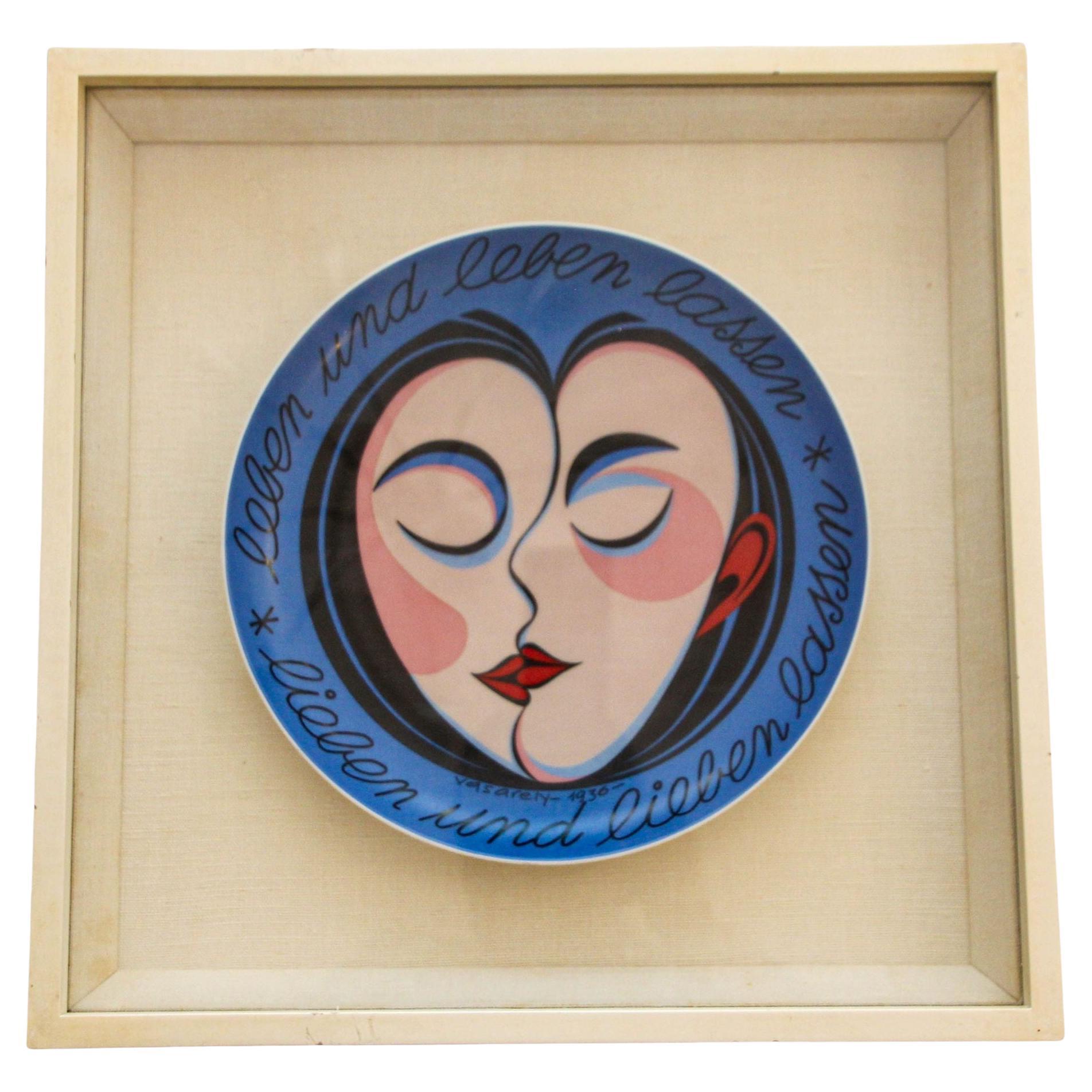Victor Vasarely Rosenthal Studio Line Limited Edition Porcelain Plate
About the Item
- Creator:Rosenthal (Manufacturer)
- Dimensions:Height: 1.19 in (3 cm)Diameter: 10.24 in (26 cm)
- Materials and Techniques:
- Place of Origin:
- Period:
- Date of Manufacture:1978
- Condition:
- Seller Location:Bochum, DE
- Reference Number:
Rosenthal
While the Rosenthal Porcelain Factory grew from humble decorating roots — as many pottery companies do — it eventually built a list of universally revered designer and artist partners that included Andy Warhol and Salvador Dalí. And after securing an enviable position as a top manufacturer of serveware and dominating the porcelain and bone china markets, Rosenthal expanded into furniture production, working with influential designers Verner Panton, Luigi Colani and Günther Ferdinand Ris and Herbert Selldorf.
German-born Jewish businessman Philipp Rosenthal founded the company in 1879 in Bavaria. It began as his modest workshop where he painted porcelain and encountered success with porcelain ashtrays. Rosenthal hired the best designers and clay modelers he could find. Adolf Oppel designed figurative Art Nouveau pieces, while Eleonore (Lore) Friedrich-Gronau produced decorative objects, namely her graceful porcelain dancer figurines, for the company.
Dinnerware, though, would be a Rosenthal mainstay. Between 1904 and 1910, Rosenthal produced its renowned dinnerware lines such as Donatello, Darmstadt and Isolde. These were introduced as unornamented white pieces — only later were they given their underglaze designs.
Rosenthal founder Philipp, a Catholic of Jewish ancestry, resigned in 1934 as the company’s president due to pressures owing to discriminatory German laws that took shape during the rise of the Nazi regime. Rosenthal died in 1937, and the family fled to America. The company would not regain its footing until 1950 when Rosenthal’s son, Philip, joined the firm and, in 1958, became chairman and dubbed Germany’s “China King.” At its peak, the company had 10,000 employees.
In the 1950s, Rosenthal’s modernist dinnerware was a significant part of the brand’s offerings, and by 1961 they introduced the famed Rosenthal Studio Line. Although furniture designers and ceramicists would lead the list of individuals working with Rosenthal — among them Tapio Wirkkala, Max Weber and Lisa Larson — the company eventually reached out to fine artists, not only Dalí and Warhol but Sandro Chia and Kenny Scharf. Rosenthal also collaborated with fashion designers Gianni Versace and Donatella Versace.
In a daring move in 1972, the company diversified into furniture, collaborating with some of the giants of mid-century modern design. The revolutionary Sunball chair, an icon of Space Age seating crafted by Selldorf and Ris, was among Rosenthal’s stellar successes in this venture.
On 1stDibs, find vintage Rosenthal ceramics, porcelain, tableware, seating and more.
- ShippingRetrieving quote...Ships From: Bochum, Germany
- Return PolicyA return for this item may be initiated within 2 days of delivery.
- Bjorn Wiinblad for Rosenthal Studio Line, Porcelain VaseBy Bjorn WiinbladLocated in Bochum, NRWBjorn Wiinblad for Rosenthal studio-linie, bird decor painted in shades of blue, Germany, 1970s Marked to the bottom. In perfect condition. Dimensions: Diameter 10 cm [3.9 in.] Heigh...Category
Vintage 1970s German Mid-Century Modern Porcelain
MaterialsPorcelain
- Vintage Bjorn Wiinblad Studio Line Rosenthal Germany - FREE SHIPPINGBy Bjorn Wiinblad, RosenthalLocated in Bochum, NRWRosenthal Studio-linie 'Arundo' vase by Bjorn Wiinblad, Germany 1986 - German porcelain. Signed Björn Winblad on the wall, makers mark on the bottom. A cute little vase of exceptiona...Category
Vintage 1980s German Mid-Century Modern Vases
MaterialsPorcelain
- Rosenthal Porcelain Hands, Germany, 1950sBy RosenthalLocated in Bochum, NRWRosenthal Porcelain hands, Germany, 1950s. Pair of hard to find original German white glazed porcelain molds for the making of latex gloves. They were immersed in vats of bubbling li...Category
Vintage 1950s German Industrial Sculptures
MaterialsPorcelain
- Rosenthal Studio-Linie Frosted Crystal BowlBy RosenthalLocated in Bochum, NRWVery elegant Rosenthal Studio-Linie scalloped crystal bowl. Frosted up to mid, clear up to top, maker's mark on upper rim, Rosenthal Studio-Linie and ...Category
Vintage 1980s German Mid-Century Modern Crystal Serveware
MaterialsCrystal
- Mid-Century Modern Rosenthal Björn Wiinblad Porcelain Noire VaseBy Bjorn Wiinblad, RosenthalLocated in Bochum, NRWWonderful black porcelain richly decorated with gold hand painting, designed by Björn Wiinblad for Rosenthal, circa 1970s. Cushion shaped, this vase will make the focus point in you...Category
Vintage 1970s German Mid-Century Modern Vases
MaterialsPorcelain
- German Porcelain Vase by Tapio Wirkkala for Rosenthal, 1980sBy Rosenthal, Tapio WirkkalaLocated in Bochum, NRWA tall, ovoid shaped white porcelain vase designed in 1970 by Tapio Wirkkala for Rosenthal Studio Line ‘Drops’ pattern as the tactile design on its exterior has raised dots, like rai...Category
Vintage 1980s German Mid-Century Modern Vases
MaterialsPorcelain
- Rosenthal Studio Line Porcelain Plate by Björn Wiinblad 'Limited Edition'By Bjorn Wiinblad, RosenthalLocated in Waddinxveen, ZHStunning wall plaque by Bjorn Wiinblad for Rosenthal. The plaque was produced in 1975 in an edition of 5000, and this one is number 1328. The text on the plate is German ‘auch die...Category
Vintage 1970s German Mid-Century Modern Shelves and Wall Cabinets
MaterialsPorcelain
- Rosenthal Studio Line Porcelain Relief Plaque by Natale Sapone 'Limited Edition'By Natale Sapone, RosenthalLocated in Waddinxveen, ZHStunning wall plaque by Natale Sapone. The plaque is "new" because it has been kept in its original box. The plaque was produced in 1972 in an edition of...Category
Vintage 1970s German Modern Shelves and Wall Cabinets
MaterialsPorcelain
- Rosenthal Studio Line Porcelaiin Otto Piene 'Limited Edition'By Otto Piene, RosenthalLocated in Waddinxveen, ZHStunning wall plaque by Otto Piene for Rosenthal. The plaque was produced in 1973 in an edition of 3000, and this one is number 1670. It is a decorative art plate in a rainbow desi...Category
Vintage 1970s German Mid-Century Modern Shelves and Wall Cabinets
MaterialsPorcelain
- Victor Vasarely Attributed Group of 48 Rosenthal TilesBy Victor Vasarely, RosenthalLocated in Naples, ITGroup of 48 Rosenthal tiles, 25 in black biscuit porcelain and 23 in white biscuit porcelain, Studio Linie collection.Category
Vintage 1970s German Mid-Century Modern Decorative Art
MaterialsPorcelain
- Original Rosenthal Porcelain Flower Plate Studio-Linie Germany by Wolfgang BauerBy Rosenthal, Wolfgang BauerLocated in Miami, FLStriking original Rosenthal porcelain hand painted flower plate designed by Wolfgang Bauer and made in Germany for Studio-Linie. This 100 Years Anniversary Collectable Wall Plate...Category
Late 20th Century German Mid-Century Modern Decorative Art
MaterialsGold Leaf
- 1970s VASARELY "Live and let live love and let love" Rosenthal Framed PlateBy Victor Vasarely, RosenthalLocated in North Hollywood, CA1970s VICTOR VASARELY "Live and let live love and let love". Rosenthal collectible framed German plate. Victor Vasarely Rosenthal Studio Line Limited Edition Porcelain Plate. By Vasarely born 1936. "Leben und Leben lassen, Lieben und Lieben lassen" "Live and let live - love and let love". Limited edition, signed and numbered. Plate is in good condition, size is 12". Frame is not in good condition, white became yellowish shows wear. Victor Vasarely, born as Győző Vásárhelyi on April 9, 1906, in Pécs, Hungary, was a Hungarian-French artist widely regarded as the "father of Op Art" (Optical Art). He is known for his pioneering work in geometric abstraction and the use of optical illusions to create visually captivating and dynamic artworks. Vasarely's early career involved studying medicine in Budapest, but he later decided to pursue his passion for art and enrolled in the Műhely (Workshop) academy in Hungary. He initially experimented with various styles, including Impressionism and Post-Impressionism, but his interest in geometric abstraction grew stronger over time. In the 1930s, Vasarely moved to Paris, where he continued to explore geometric patterns, lines, and shapes in his art. He believed that art should not merely imitate nature but should create its own language of forms and colors to engage the viewer's perception actively. This philosophy led to the development of Op Art, a movement that emerged in the 1960s and focused on creating optical illusions and visual effects through precise geometric patterns and colors. Vasarely's artworks often featured meticulously arranged geometric shapes, giving the impression of movement and three-dimensionality. He employed various optical tricks, such as the juxtaposition of contrasting colors and the use of repetition, to create an illusion of depth and visual dynamism. His artworks can evoke a sense of visual vibration and often challenge the viewer's perception. Throughout his career, Vasarely's influence extended beyond the art world. He believed in the democratization of art and wanted to make art accessible to a wider audience. He embraced mass production techniques, creating what he called "multiple originals" or "serigraphs" (a form of screen printing). These serigraphs allowed him to produce multiple copies of his artworks at affordable prices, making them more accessible to art enthusiasts. Vasarely's artistic legacy continues to be celebrated around the world. His work has been exhibited in numerous galleries and museums, and he remains an influential figure in the fields of Op Art and abstract geometric art. He passed away on March 15, 1997, in Paris, leaving behind a vast body of work that continues to captivate audiences and inspire artists to this day. About Rosenthal: German porcelain manufactory Rosenthal was originally founded as a ceramics-painting studio by Philipp Rosenthal Sr. (1855-1937) in 1879 at Schloss Erkersreuth in Bavaria, near the Czech border. Its first highly popular product was an ashtray inscribed with the words “Resting place for lit cigars.” In 1890, the company moved to the neighboring hamlet of Selb and, a year later, began to manufacture its own porcelain, since white porcelain was, at that time, in short supply. Rosenthal’s first complete table service was called Empire; it was exhibited along with other lines at Paris’s Exposition Universelle in 1900. With the dawn of the 20th century, Rosenthal began producing porcelain tableware and services formed and decorated in the latest styles, like the Jugendstil Botticelli (1903), the Art Nouveau Darmstadt (1905), and the all-white Maria (1916) lines. Successes with this au courant approach led the company to launch an art pottery division in 1910, dedicated to luxury tableware, vases, and other decorative objects. By the 1930s, figurines were another important Rosenthal product, most notably the Disney-licensed Mickey Mouse pieces introduced in 1931. In 1934, Philipp Rosenthal was forced to leave his company and country when his Jewish ancestry came under persecution by the Nazi regime. Despite the loss of its founder, the Rosenthal company remained the premier supplier of high-quality porcelain tableware to the Third Reich. After the war, in 1950, Philip Rosenthal Jr. (1916-2001) joined his father's company as an advertising manager. By 1958, he had become its CEO, continuing his father’s vision to produce high-quality porcelain in line with progressive tastes. Through the rest of the 20th century, Rosenthal was the most commercially successful porcelain producer in Germany. In the postwar era, Rosenthal’s most famous tableware lines have included 2000 by Raymond Loewy and Richard Latham (1954), Magic Flute by Bjørn Wiinblad (1959), Suomi by Timo Sarpaneva (1976), and Moon by Jasper Morrison (1997). The company has enjoyed many popular and critically acclaimed collaborations with designers and brands, like Salvador Dalì, Tapio Wirkkala, Walter Gropius, Andy Warhol, Ron Arad, Enzo Mari, Konstantin Grcic, and Versace. Rosenthal's product lines have encompassed more than ceramics over the years. In 1972, the company began producing furniture, under the subsidiary Rosenthal Einrichtung, in Espelkamp, Germany. Standouts from this arm of Rosenthal include Gunter Ferdinand Ris and Herbert Selldorf’s futuristic Sunball Lounge Chair (1969), Verner Panton’s Relaxer Rocking Chair (1974), Burchard Vogtherr's Vario Pillo...Category
Late 20th Century German Post-Modern Decorative Art
MaterialsPorcelain
